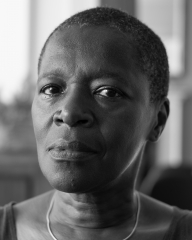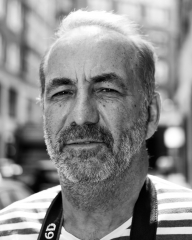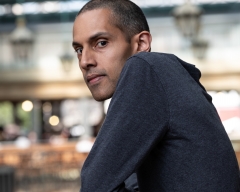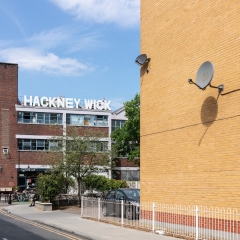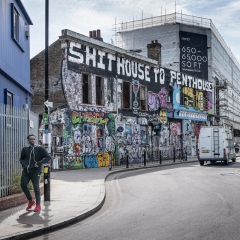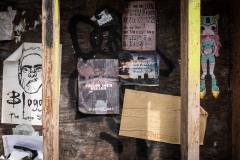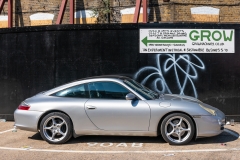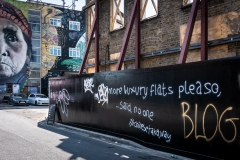Did portraiture course at City Lit last week. Preparation for getting to grips with portraits for major project. Made studio and street images with natural light, studio lighting (flash and constant) and on camera flash (including fill in). Lots to learn, but now at least have a basic grounding. And some ideas around the use of backdrops in the field. Selection of images below.
Genre, practice and value: Week 9 reflection
I don’t want to define my practice in terms of ready at hand photographic genres (landscape, architectural, abstract, social documentary, still life, portrait, street and so on). In part this relates to where I am in my photographic (re)education, and the need, at this point in time, to resist being constrained by a tight association with any given approach to photographic image making. On the positive side, this gives me the space to explore and learn. Negatively, the lack of a defined (or definable) genre-related community places limits on productive critical engagement with, and induction into, a community of practice (as described by Lave and Wenger, 1991). More profoundly and productively, perhaps, evasion of association with a genre, or with a school or approach, allows greater dynamism in the development of practice, and openness to photography’s integration with, supplementation of or subjection to, other disciplines and domains of practice in addressing complex and enduring issues in inter-disciplinary collaboration. It does not, though, free me of the obligation to position my work within the field of photographic arts, and to demonstrate knowledge of and respect for appropriate schools of and approaches to photography (there’s a possible footnote here relating to Billy Childish, and ‘Stuckism’, and the personal and professional consequences of relatively unmediated engagement with the production of art and resulting outsider status).
The ubiquity of digital image-making sharpens our awareness of a need to distinguish between, and address constructively, the forms of understanding of photography from within the discourse and practice of photography, and that from outside (both from other disciplines and areas of practice, and what we might call ‘popular’ conceptions of photography). The proposal to attempt to construct a shared understanding of quality (or value) made by Francis Hodgson seems excessively limiting, perhaps even dangerous, in this respect. Whilst recognition of the possibility of accusation of elitism is evident, the longstanding, and, depressingly, enduring elitist distinction between ‘high’ (deep and worthy of attention) and ‘low’ (trivial and fleeting) culture is invoked, and little is done to mitigate its divisive effects. How is the ‘we’ that has the authority to determine quality constituted? And what are the consequences of alternative conceptions of quality? And who polices attention, and thus underwrites value? The importance of an absolute (or as near as possible) index of value is clearly of interest to auction houses, galleries and collectors, but mis-recognises the nature of artistic practice in relation to the multiplicity of contexts within with images are produced and circulated (and the forms of production, circulation and exchange). In simple terms, the fundamental flaw is that images are assessed apart from their contexts, and assigned a place along a (supposedly neutral, though in practice culturally loaded) continuum of relative worth (and thus treated as the same in all but value). Rather than the creation of an index of value (akin to an international standard in relation to service, manufacture and measurement), value in the arts might, more appropriately and constructively, be seen as dynamic, contested and contextual. Within and across contexts, the attribution of value (and what is worthy of attention) is a practical accomplishment, within which the possibility of alternatives is always imminent. It is not that there is a lack of agreed criteria for judging the quality of a photographic work, as implied by Hodgson, but rather that there is a multiplicity of sets of criteria, which vary according to context and interest. And it is contestation and debate within, and tensions between, these socially and culturally contextualised sets of criteria that, in part, ensures dynamism in the arts and creates the space for, and ensures the possibility of, creativity.
For me, then, at this moment, image making is a means of address that provokes alternative ways of apprehending and understanding. To that end I am both interested in advancing my own image making, and exploring image making collaboratively with others in investigation of common concern. That collective endeavour brings to the fore tendencies in relation to genres. My own explorations of place have tended to exclude human figures (though human activity is clearly evident), highlighting a ‘lack’ in relation to what might be considered documentary photography or portraiture, for instance. The creates the opportunity to expand my practice. The focus and coherence is provided not by the photographic genre, but by the underlying intent, and the mode of operation, which warrants more careful consideration and development. Whilst I am comfortable in identifying with post-representational forms of photography, the collaborative endeavour brings representation back in (through, for instance, the interests of others in utilisation of photography’s indexicality to represent and persuade). Just one of many creative tensions.
Lave, J. and Wenger, E. (1991) Situated Learning: Legitimate Peripheral Participation. Cambridge: Cambridge University Press.
…………………………
Week 8: Work in progress portfolio
I’d wanted to present the Roding Valley work as three vertical triptychs (as per earlier post), but the portfoliobox templates don’t include a static 3 column design, so presenting the images as a 3 by 3 grid (that appears as such in any resolution and on a monitor of any size) can’t be done ‘out of the box’. It is possible to customise the css and javascript, but you have to get support to implement that, which I’ve done. Now working on adapting one of the templates to allow a static 3 column design. The 12 images in the WIP portfolio would then be 9 from RVP, and 3 from Hackney Wick (on a second page) to show how I’m intending to build on the RVP project to develop the proposal for the final project.
There is an alternative. Present 4 images each from RVP, Newcastle Ocean Pool and Hackney Wick. The rationale would be to present three projects from this term that have addressed the question of contested space (all explained in the Week 7 Presentation and elaborated in the research proposal).
Not sure which way to go with this. Will be good to discuss with others in the webinar and get their thoughts. Work in Progress portfolio is here.
Update following webinar feedback. I’ve replaced the top right image (had to go out to get some new material this weekend) and have given names to the collections, as well as some minor editing of images. I’m now committed to the Roding Valley Park and Hackney Wick collections. Hopefully good to go.
Week 7: Peer commissioned micro project
A compare and contrast brief from Michael Turner (KCL on the left, UCL on the right). Not a great success, with limited opportunities to get out this week. And not able to get into KCL (hence the ‘Welcome to King’s image below)!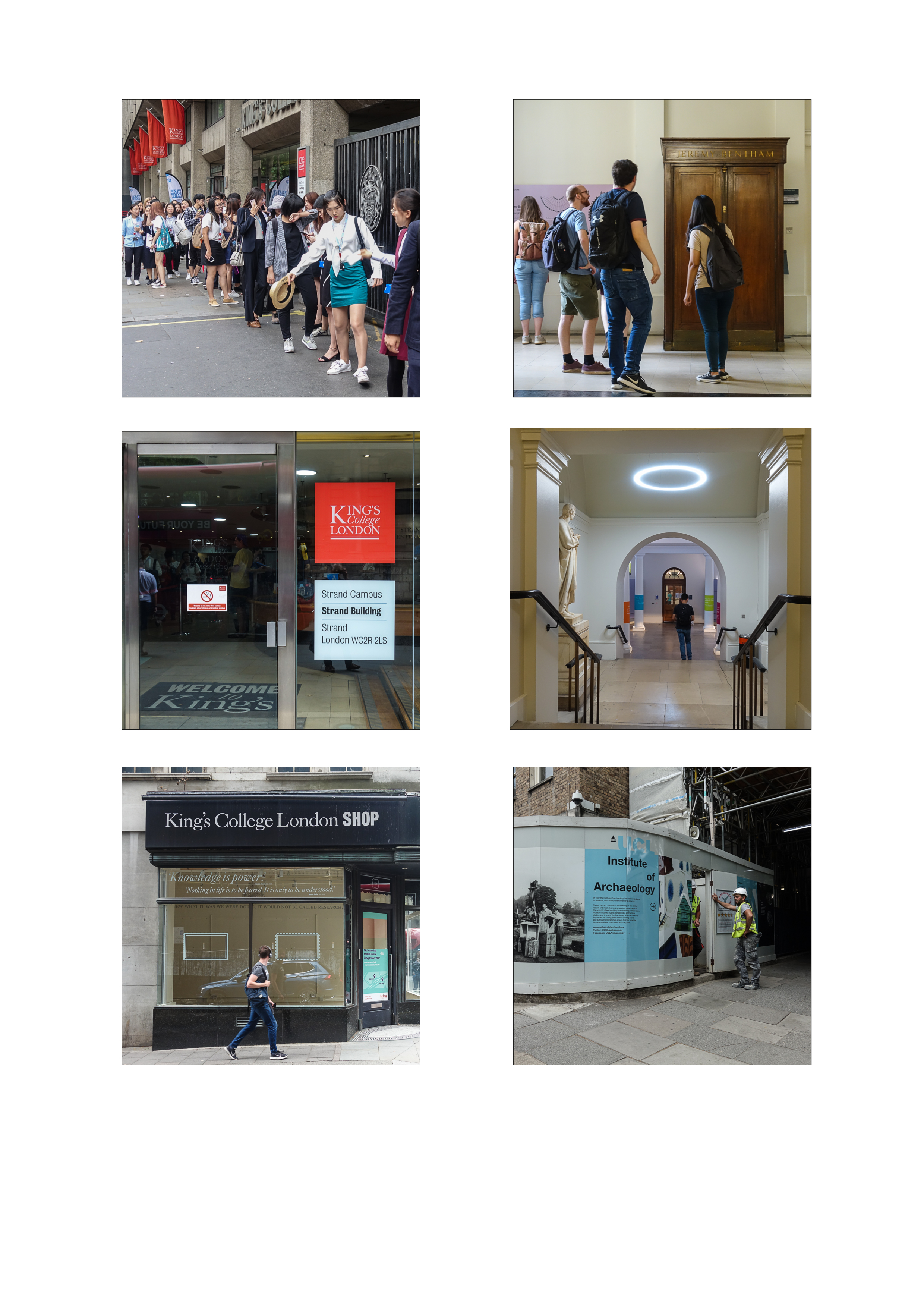
Hackney Wick
Oral presentation
Final submitted version of the Oral presentation.
Public private writing
I am still struggling with the idea of producing a reflective journal that is both a public document and a component in the assessment of an award bearing course. This struggle is both intellectual (I am having difficulty in getting my head around it) and emotional (I am not sure about how I feel about it). I am not going to be able to resolve these struggles here, but should, at least, produce a practical resolution (how I am going to deal with it). And, of course, that resolution might only be momentary, and subject to revision as I progress through.
The simplest resolution might appear to be performative. Treat successful completion of the degree as the primary function, and manicure the postings to project the image of a successful student. This is a tried and tested approach to any form of reflective journal (I am relatively sure that Erica McWilliam has written something about this in relation to the journals produced by beginning teachers, which I need to check). It is high risk, though, as, to be successful, it requires the writer to have a clear sense of the principles of assessment of the programme (what are the assessors looking for), and the ability to produce appropriate evidence. So, to a degree, you have to be an adept to be able to produce a text that passes as that of a successful student. And there are complexities as the tacit criteria might require failure (and recovery) as part of the process. That is that, the writer may have to walk the tightrope of manufacturing a sufficient vulnerability on the path to ultimate success. There may also be a requirement for a degree of perceived authenticity, or revelation of a sufficient sense of self to authenticate the postings (bearing a watermark). A thought about blockchain technology has just come to mind, where ‘who you are’ is encoded and preserved for future authentication (though that is an excessively static conception of self). I’m not going to pursue that here. Anyway, here we are only addressing the inward (course assessment) element of the journal. Managing this alongside projection of a public persona adds a further, very demanding, level of complexity.
This is, in any case, an excessively cynical approach, to my mind, and there is the strong odour of bad faith. However, it does not have to be a total strategy, and in making any statement in this kind of environment there will always be a degree of self-checking (what are the consequences of publishing this?). So performativity as a total strategy stinks, but a degree of performativity (a manicured projection of self) is inevitable. The act of writing (and the reflection that that involves) means that we can never just ‘get it all out there’. Writing requires selection and expression and slows things down, though tweeting clearly allows people to just ‘blurt it out’ (to millions of others in some cases). This is not the place to wrestle with Derrida (there’s a post coming on that in due course).
To bring this post to a hasty conclusion, I think my approach is to treat this as a genuinely educational opportunity. To formulate and convey emerging thoughts and practices in a new (for me) domain of endeavour produces something to think about that moves practice forward in, potentially, dialogue and engagement with fellow travellers. To do otherwise is a lost opportunity to learn. Of course, to learn is the primary objective for me in doing this course, and the stakes are relatively low in that there are no professional or life-chance consequences to success or failure (and only a few personal consequences, mostly related to self-esteem). To a degree, posting to the blog enables me to formalise and organise my thinking, to put down markers and to remember (and there will be a post on memory ‘prosthetics’; aids to supplement ageing cognitive functioning). It is a place to build something in public view.
Why not do this in private? That, maybe, is to do with the positive pressure that the public exposure exerts to take some care in expressing thoughts (but not the degree of care needed for a published paper or book). And it provides a framework for organisation of thoughts and experiences around a particular project (growing as a photographer, and understanding the field), that might also offer something of value to others. And memory is important, too (‘but you said …’). How do I feel about the bleeding out of what is written here to other domains of practice? That’s uncertain. This is for a pedagogic purpose, and it is about exploration not exposition. It’s a supplement to, not replacement of, identity and practice in other areas of life.
Draft presentation feedback
Really useful feedback from Michael on initial draft, and on the draft video from others in the webinar this week. Michael encouraged me to be more confident in presentation of my work and ‘project a positive view as an artist’, which helped me to take out the hedging, and to feel more positively about my work myself. He also asked what kind of photographer I was. Thinking this through, I decided to present crossing genres (and resisting, for instance, being a landscape, or and architectural, or a documentary photographer) as a positive aspect of my practice (and not having to develop a professional identity helps me to be able to do this). I moved the ‘swimmer’ image to the beginning of the pool images – he was absolutely right about the need to give a clearer sense of context for these images. I also tried (and failed) to say less about the images (maybe at a later point in time; for the moment anxiety rules). All much appreciated.
Jesse suggested I could lose the material on the RPS award and use the time to better effect – I agree, and will do that. Catarina observed that whilst a chronological organisation has some benefits, it would be better to put the Roding Valley Park material together. Absolutely – will do that for sure. Paul, as ever, provided numerous pathways and other photographers to follow up. I have a list, and will get to work on these. Thanks, everyone.
I’m leaving the draft in the CRJ by way of illustration of development.
Artists on the cutting room floor
Putting together the draft presentation for this module provoked me to think about my engagement with the work of particular artists. I can’t say artists that have influenced me, as I don’t, as yet, have a sufficiently mature practice to have been influenced. These are artists that I have encountered as a viewer, and have been engaged by their work. None of this will go into the presentation, but I want to continue to think about my relationship with particular bodies of work, so some simple blog posts might help to do this.
The artists that immediately came to mind were: Gerhard Richter, Cy Twombly, Helen Chadwick, Peter Greenaway, Simon Hantai, Richard Long and Keith Arnatt. In each case there are either particular exhibitions or particular works that have left an impression (sometimes both, the latter leading to the former or vice versa). All except Hantai have produced photographic work. It would be mundane to just take the artist and write about them, and this kind of cataloguing wouldn’t provide a sufficient motivation for me to do it. Rather, I will take a theme to explore in each case. First throughs are: blur (Richter), myth (Twombly), self (Chadwick), process (Hantai), classification (Greenaway), movement (Long) and performance (Arnatt). But that might change. And there are others in the waiting room.
Draft presentation: Week 6
For discussion at the webinar on Friday 13th July. It took a while to find the right tools to do this. In the end, I used Keynote to put together the presentation and do the voice-over. Then exported as a movie and edited in QuickTime Player before uploading to Vimeo, and embedding the video here in my CRJ. This is a first attempt at the draft. I need a couple more images – one for the spoken introduction (to go on or after the title page) and one for the end of the presentation (to go before the references). The references are a work in progress. I assume that it is OK to use the images under fair use, but would like advice on that before publicly posting the final presentation. There are a few stumbles here and there – I’ll re-record when the final form of the presentation is decided. All feedback welcome.


